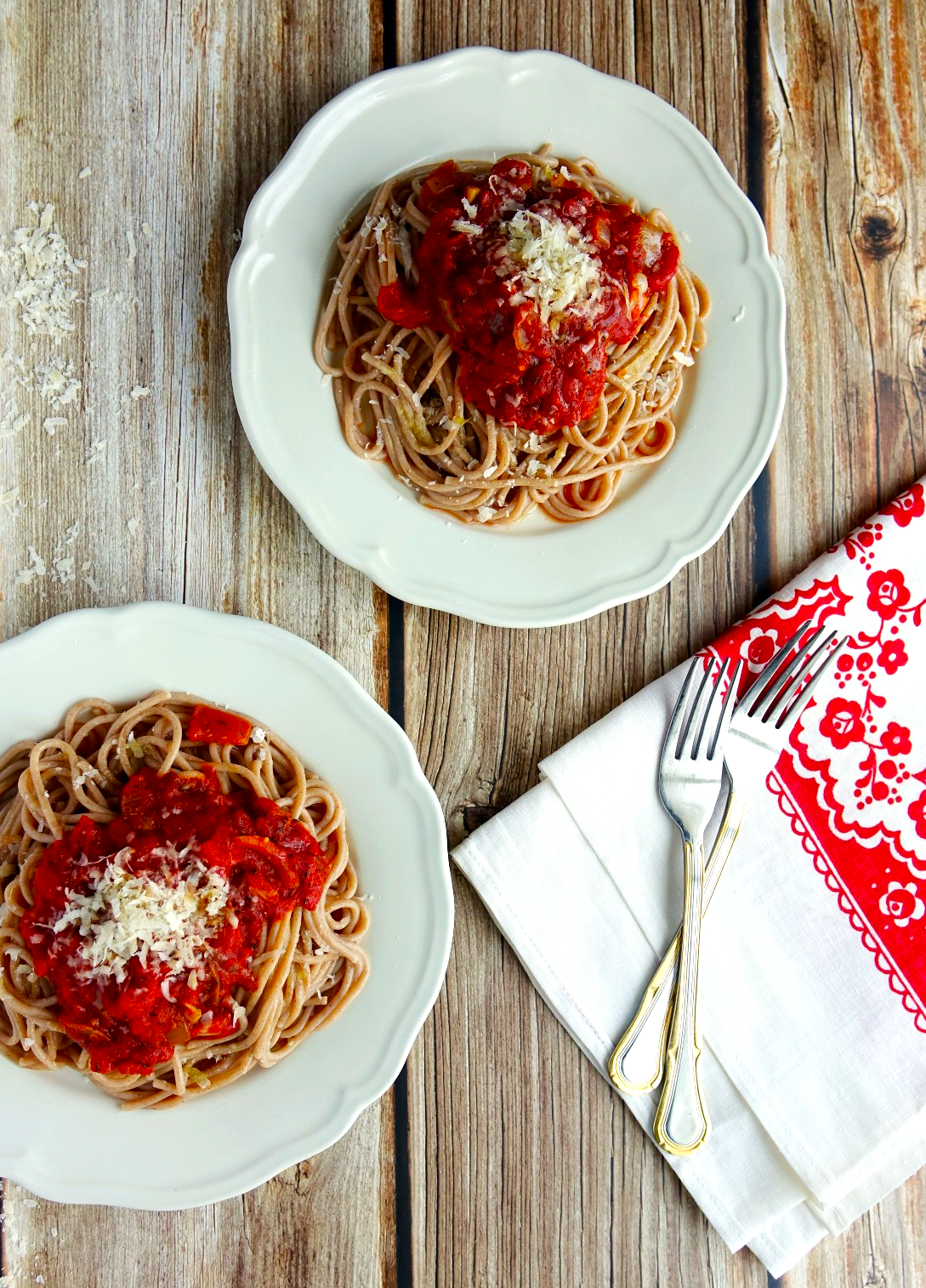Craving a classic Italian comfort food? This Spaghetti with Tomato Sauce recipe, also known as Spaghetti and Tomato Sauce, is a guaranteed crowd-pleaser. Whether you’re looking for an easy spaghetti recipe for a weeknight dinner, a delicious homemade spaghetti sauce, or simply the best sauce to top your pasta, this recipe delivers. We use whole wheat spaghetti for a healthier twist, making it a perfect option for family dinner ideas. This tomato basil sauce is simple to prepare, making it a fantastic quick dinner recipe that even the pickiest eaters will love. Enjoy this authentic Italian spaghetti recipe and discover how easy it is to create a restaurant-quality meal at home.
Spaghetti
- 300 grams of whole-wheat spaghetti/pasta
- Salt-to taste
- Three tbsp. of grated Parmezan cheese
- Three tbsp. of olive oil
Tomato Sauce
- Five tbsp. of olive oil
- Three tbsp. of tomato paste
- Five tbsp. of olive oil
- One cooking onion
- Two-three cloves of garlic, minced
- 350 ml. of bottled Tomato Passata or canned whole peeled tomatoes with liquid
- Dried basil - one tbsp.
- One tsp. of dried thyme (optional)
- Salt- to taste.
- Five tbsp. of olive oil
- One tsp. of black pepper
- Two tbsp. of chopped fresh basil, or one tbsp. of dried basil.
- Skillet or saucepan
- Wooden spoon
- Measuring spoons
- Measuring cups
- Knife
- Cutting board
- Cheese grater
Cooking Pasta
- Fill a large pot with water and bring it to a boil. Add ½ tablespoon of salt to the water, adding flavor to the pasta itself.
- Add the whole-grain spaghetti to the boiling water. Stir occasionally to prevent sticking. Cook according to the package instructions until it’s al dente — usually around 8-10 minutes.
- Once cooked, drain the spaghetti and return it to the pot. Toss with three tablespoons of olive oil, giving it an excellent gloss and preventing it from sticking together.
- Sprinkle with grated Parmesan cheese while the pasta is still warm. The heat will help the cheese melt slightly, infusing the pasta with a creamy texture.
Cooking Tomato Sauce
- In a saucepan, heat 3 tablespoons of olive oil over medium heat.
- Add the minced onion and garlic, sautéing until the onion is translucent and fragrant.
- Stir in the canned tomatoes (with liquid) or tomato puree. If using whole peeled tomatoes, break them up with a spoon.
- Mix in the tomato paste, dried thyme (if using), and black pepper. Let the sauce simmer gently, stirring occasionally.
- Allow the sauce to simmer for about 20 minutes. If it thickens too much, add a bit of water to reach your desired consistency.
- Towards the end of cooking, stir in the fresh or dried basil. This will infuse the sauce with a delightful herby aroma.
- Pour the tomato basil sauce over the cooked spaghetti.
- Toss everything gently to ensure the pasta is evenly coated with the sauce.
- Top with extra grated Parmesan and a few basil leaves for a touch of elegance
- Serve with a fresh green salad or garlic bread for a complete meal.
- Feel free to adjust the seasonings according to your taste. Like it spicy? Add a pinch of red pepper flakes. Love garlic? Throw in an extra clove. The beauty of this recipe is its flexibility and the warm, comforting meal it creates.
- Right Pot Size: Choose a large pot to give the pasta space to cook evenly. A general rule is about 4-6 quarts of water for every 100 grams of pasta.
- Salt the Water Well: Don’t be shy with the salt. It’s crucial for adding flavor to the pasta itself. Think of the water as seawater.
- Avoid Overcooking: Keep tasting the pasta as it nears the end of its cooking time. Whole-grain pasta can quickly turn from perfect to overcooked.
- Reserve Pasta Water: Before draining, save a cup of pasta water. It’s great for adjusting the sauce consistency later.
- You can make a delicious Tomato Souse for spaghetti from fresh or canned tomatoes and tomato puree. Specifically, peeled canned plum tomatoes are the most popular in preparing tomato sauces. Also this delicious tomato sauce recipe is also suitable for pizza.
- Cooking the Onion and Garlic: Ensure the onion is soft and the garlic is fragrant but not burnt.
- Simmering Time: Simmering allows the flavors to meld and deepen. Letting it simmer longer (even up to an hour on low heat) can enhance the taste if you have time.
- Fresh vs. Dried Herbs: Fresh basil adds a bright, fresh flavor, especially if added at the end. Dried herbs are more concentrated, so use them sparingly.
- Adjusting Thickness: Use the reserved pasta water to adjust the sauce’s consistency if it seems too thick.
- Serve Immediately: Pasta with sauce is best served immediately while it’s hot and the flavors are at their peak.
- Cheese Matters: Use high-quality Parmesan cheese for the best flavor. Grate it yourself for a fresher taste and better melting.
- Storage: Cooked pasta can be stored in the refrigerator for 3 to 5 days. To maximize its shelf life, place the pasta in an airtight container to prevent moisture loss and minimize exposure to air. If the pasta is mixed with sauce or other ingredients, it may spoil more quickly, so it’s advisable to store plain pasta and sauce separately when possible. Always check for signs of spoilage, such as mold or an off smell, before consuming.
- Enjoy the process and the delicious meal you’re about to create!
Taste is subjective, but sauces with high-quality tomatoes, olive oil, and natural seasonings are generally preferred.
Tomato-based sauces, like tomato basil sauce, are classic pairings due to their acidity and flavor balance.
Spaghetti sauce has its roots in Italian cuisine, evolving from simple tomato sauces to various styles incorporating different ingredients.

